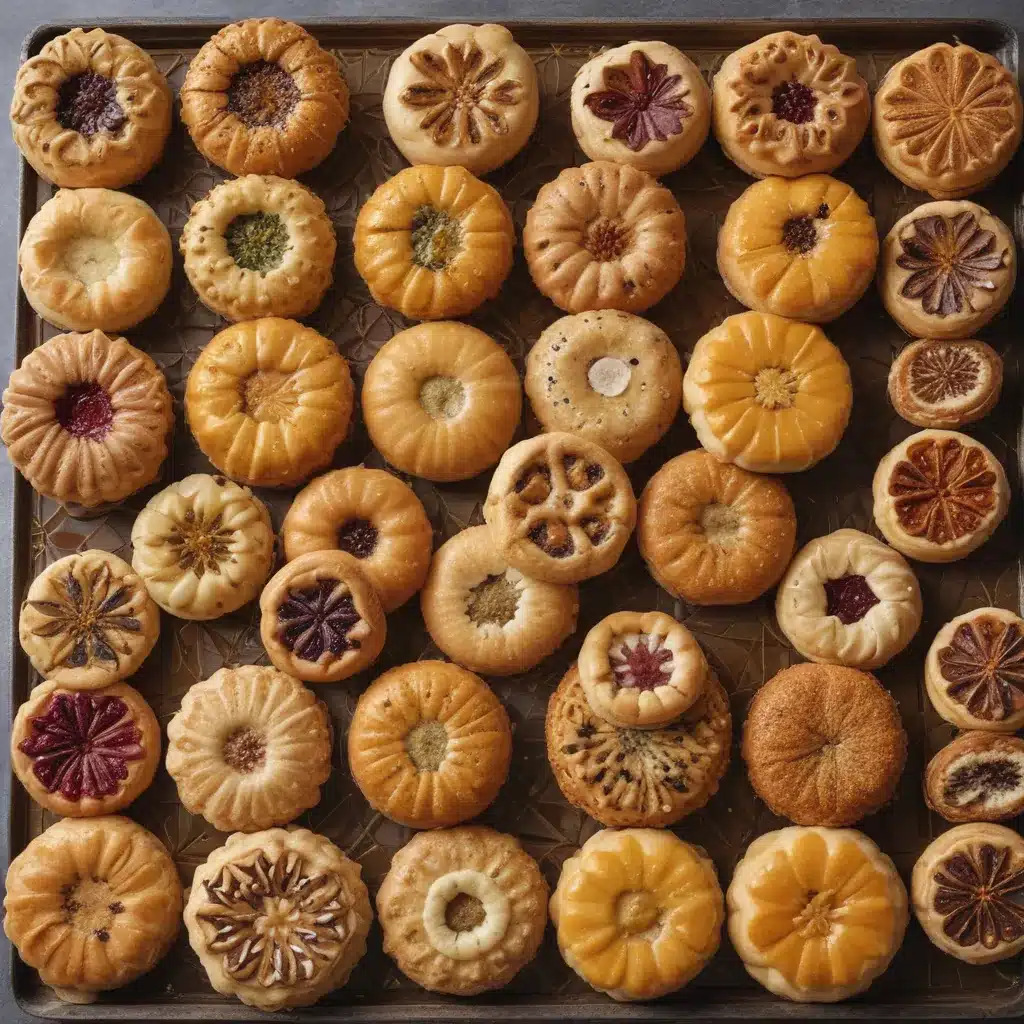
A Sweet and Savory Symphony
My first encounter with the mystical Moroccan pastry known as bstilla was a moment of pure culinary enlightenment. I can still vividly recall that fateful day in the 1970s, when I visited Marrakech and had the pleasure of indulging in this extraordinary dish. Our host had prepared a veritable feast, and the bstilla was the showstopper that kicked off the meal.
As I delicately broke through the thin, crispy pastry dusted with cinnamon and sugar, a world of flavors unfolded before me. Gently extracting a tiny drumstick with my fingers, I was instructed to suck the meat off the bone and then pinch off a morsel of the pastry, combining it with the rest of the filling to create the perfect bite. The interplay of sweet and savory, coupled with the complex spicing, was a revelation – a symphony of tastes that was completely foreign to my Lebanese palate.
That first bite was a watershed moment, sparking a deep fascination with Moroccan cuisine that has endured to this day. On subsequent trips to Morocco, I found myself on a quest to uncover the secrets behind this captivating dish.
The Origins of Bstilla
Bstilla, also known as bisteeya or pastilla, is a true culinary treasure, typically served at weddings and other festive occasions in Morocco. Its origins can be traced back to the kitchens of the Arab caliphs who founded the country in the seventh century AD, bringing with them Persian chefs who introduced this savory-sweet delicacy.
The dish’s traditional pastry, called warqa in Arabic, shares its roots with similar doughs found in Moorish Spain. When Muslims were expelled from Andalusia in the eighth century, they sought refuge in the city of Fez, bringing their pastry traditions with them. It is in Fez that the bstilla has now become a specialty, crafted by skilled cooks and specialized market vendors.
According to Anissa Helou, the creation of warqa is an art form in itself. It is made by dabbing very wet dough against a scorching tobsil, a circular metal plate, in quick successive motions, like a game of culinary “yo-yo.” Each time the dough touches the hot surface, it leaves a light coating, eventually forming a delicate, gossamer-like disk of pastry.
Adapting Bstilla for the Modern Kitchen
In my London kitchen, I’ve had to adapt the recipe to use more readily available ingredients. Instead of the traditional warqa and pigeon meat, I’ve opted for phyllo dough and chicken or quail. To recreate the complex flavors, I stew the poultry with fresh herbs like parsley and cilantro, as well as ras el hanout, a North African spice blend featuring cardamom, clove, fennel, and chili.
Rather than assembling the dish in the traditional layers, with the bone-in stewed bird wedged between a top coat of ground almonds and a bed of eggs scrambled in the stew’s sauce, I’ve created a composite filling. I pull the meat off the bone, shredding it into the eggs and almonds for a more cohesive experience.
As Paula Wolfert suggests, the bstilla is typically cooked on a tobsil and flipped midway like a pancake. However, for the convenience of the modern kitchen, I bake my pie in the oven, allowing it to take on a uniform golden crispness.
The final flourish is faithful to the original – I dust the bstilla with confectioners’ sugar and decorate it with lines of ground cinnamon in the shape of diamonds or squares. It’s a presentation that still evokes the celebratory nature of this magnificent dish.
Savoring the Sweet and Savory Harmony
Four decades after that initial exquisite mouthful, eating bstilla – and cooking it – still feels like a celebration. The harmony of sweet and savory flavors continues to captivate me, transporting me back to the vibrant sights and sounds of Marrakech.
The bstilla is a true embodiment of the Moroccan culinary tradition, where the interplay of opposites is celebrated and elevated to an art form. It is a dish that challenges our preconceptions and delights our senses, proving that the most unexpected combinations can create culinary magic.
As I indulge in a slice of bstilla at El Bahia, the Moroccan restaurant in New York City, I am reminded of the rich cultural tapestry that has shaped this remarkable pastry. Each bite is a testament to the ingenuity and artistry of Moroccan cuisine, where the sweet and the savory dance in perfect harmony.
Discovering the Wonders of Moroccan Pastries
Moroccan cuisine is justifiably hailed as the most sophisticated in all of Africa, owing to its rich history of invasion, colonization, and cross-migration. This unique cultural legacy has imbued Moroccan dishes with a remarkable depth of flavor, blending the influences of the indigenous Berbers, the conquering Arabs, the colonizing Europeans, and the Moors who fled from Spain during the Inquisition.
As Anissa Helou observed, Moroccan cuisine boasts a world-famous tradition of hospitality and a culture of kitchen artistry, where secret recipes are passed down from generation to generation like priceless family treasures. And while there may be fierce regionalism and loyalty to the particular foodways of one’s home soil, there is a near-universal consensus on the true crown jewel of Moroccan cuisine – the flaky, sugar-dusted meat pastry known as bstilla.
Unraveling the Mysteries of Bstilla
The origins of bstilla have long been a subject of debate and speculation. The current wisdom holds that it was brought back by the Moors when they left Spain in the fifteenth century, due to the similarity between bstilla and the Spanish word for pastry, pastel. However, Paula Wolfert offers a different theory, suggesting that bstilla stems from an old Berber word for a dish of chicken cooked in saffron, bestila, to which a pastry innovation from the Chinese was applied.
Wolfert’s hypothesis posits that the Moroccan warka pastry, rather than emerging as a variation on European thin pastries such as filo or strudel, made its way to Morocco from China via Persian and Arab traders. The technique of dabbing a ball of wet dough over a hot griddle until a thin sheet can be peeled off, much like the creation of Chinese spring roll wrappers, lends credence to this theory.
Regardless of its precise origins, one thing is certain – nowhere else in the world, and particularly not in Spain, will you find anything remotely resembling the magnificent bstilla. It is an extravagant and magical dish, an event unto itself, rather than just a simple sustenance.
The Sublime Taste of Bstilla
Imagine crisp, gossamer-thin pastry encasing layers of spiced chicken, lemony eggs, tangy onion sauce, and butter-fried almonds, baked until golden and then liberally dusted with cinnamon and sugar. The combination may sound peculiar, but the taste is anything but. A single bite encompasses a symphony of flavors, from the spicy to the herbal, the sour to the pungent, the nutty to the creamy, the salty to the sweet.
While bstilla is traditionally served as a first course during large celebration meals, a communal pastry for everyone to tear into with their fingers, it is also hearty and filling enough to serve as the pièce de résistance of a considerably smaller affair. Whether you enjoy it as part of a no-holds-barred feast or as a simple dinner with mint tea and a salad, bstilla is a truly spectacular dish, one that I daresay would outshine even the most cutting-edge gastronomic creations.
Embracing the Wonders of Moroccan Pastries
As I savor each bite of the bstilla at El Bahia, I am struck by the sheer genius of Moroccan cuisine. The ability to seamlessly blend sweet and savory flavors, to create a harmony of opposing tastes that delights the senses, is a true hallmark of this remarkable culinary tradition.
Whether it’s the bstilla, the decadent mind-blowingly opulent feasts encompassing up to twenty different courses, or the world-famous hospitality that permeates Moroccan culture, there is an undeniable artistry and sophistication that sets this cuisine apart. It is a culinary journey that transports me back to the vibrant sights, sounds, and aromas of Marrakech, a testament to the rich cultural tapestry that has shaped the Moroccan palate.
As I leave El Bahia, my heart full and my taste buds still tingling, I know that my love affair with Moroccan pastries is far from over. The interplay of sweet and savory will continue to captivate and delight me, reminding me that the most unexpected combinations can create culinary magic. And I can’t wait to see what other wonders the Moroccan culinary landscape has in store for me.


